Your cart is currently empty!
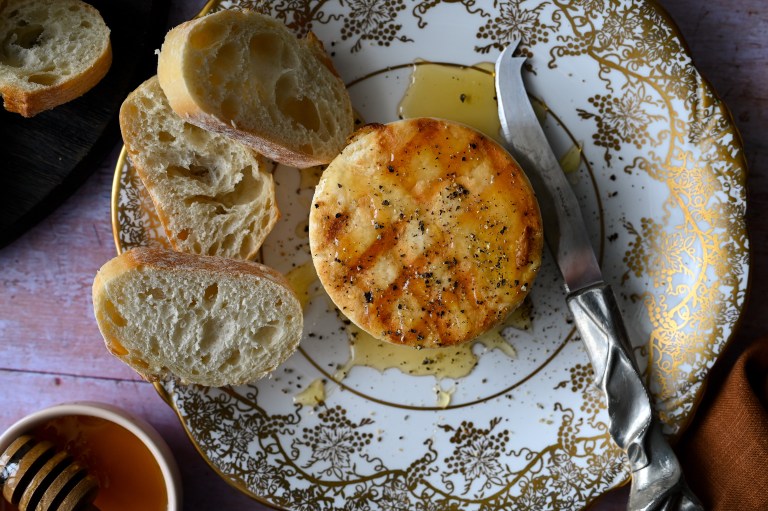
Taking the guesswork out of Greek cooking…one cup at a time

Pastitsio (also Pastichio) is a classic Greek pasta bake made with pasta, meat sauce and topped with béchamel.
NOTE: We have 2 recipe boxes below. The first recipe box is for a pan that is 11 x 16 inches; and the second recipe box is for a pan that is 9 X 13 inches.
We have 4 daughters between us and when they were pre-schoolers our parents cared for each of them while we returned to work after a blissful year or two of maternity leave. Not only were our children embraced by papou and yiayia’s love every day, they were also exposed almost exclusively to the Greek language and their Greek heritage. How special, and how blessed we all were! As if that weren’t enough, their bellies were filled daily with nutritious, home-cooked meals which were essentially made-to-order. If our daughters wanted to snack on milk and freshly made Greek cookies (koulourakia), our parents set to baking. When they craved spaghetti, the water was boiling before they could even say “σε παρακαλώ” (please). If they wanted chicken and there wasn’t any in the house, papou would run (practically) to the market to pick some up. Nothing was too much trouble, and to this day, especially when it comes to their grand-daughters, nothing ever is.
Although each of our girls had her particular favourite, one meal which was often requested by all of them was, and still is, pastitsio. It seems that their taste buds are similar to many of yours because since starting this blog a few short months ago, pastitsio is a recipe which many of you have requested as well. So, here it is. 🙂

Pastitsio (sometimes spelled pastichio) is a layered, baked dish which includes pasta noodles, ground meat and a béchamel sauce. It is a classic Greek meal, often invited to celebrations and large family gatherings. It may seem complex, but like our moussaka, the different components involved are actually pretty simple. And, as with moussaka, some of the steps, like boiling the noodles and preparing the meat sauce, can be done the day before, cutting down the prep time so that pastitsio can even make it onto your weekday menu plan.
Along with our love of pastitsio however comes a particular pastitsio pet peeve. We cringe just a little whenever we hear pastitsio described as a Greek lasagna. We know that lasagna is delicious, and many Greeks, including our parents, make lasagna…but pastitsio is not lasagna. Sure, they both include pasta, and lasagna often includes ground meat, and they are both baked…but so what? Pumpkins and carrots are both orange vegetables that can be turned into delicious soups, but you would never think to call a carrot a skinny, root pumpkin, would you? Pastitsio is pastitsio, a dish so delicious, so beautifully its own, that it deserves to be referred to by its proper name. Thanks 🙂
If you love pasta, we think you’d love our “Spanakopita mac and cheese”. Watch video below:
Helpful hints:
As you may notice when reading the recipes below (remember, there are two recipe boxes, for two different pan sizes of pastitsio), the meat sauce may appear very familiar. That is because it is essentially the same meat sauce recipe which is used for our parents’ spaghetti and meat sauce. This is great because if you have meat sauce left over, you can boil some pasta the next day and have a different meal.
You can also freeze the leftovers for a great last minute lunch option. In fact, if you follow the recipe exactly as described, you will most definitely have meat sauce left over because our parents do not use all that is made for the pastitsio. Why do they prepare more meat sauce than they need? They figure that if they are going through the effort of making the meat sauce, may as well get two meals out of it. They are very practical people.
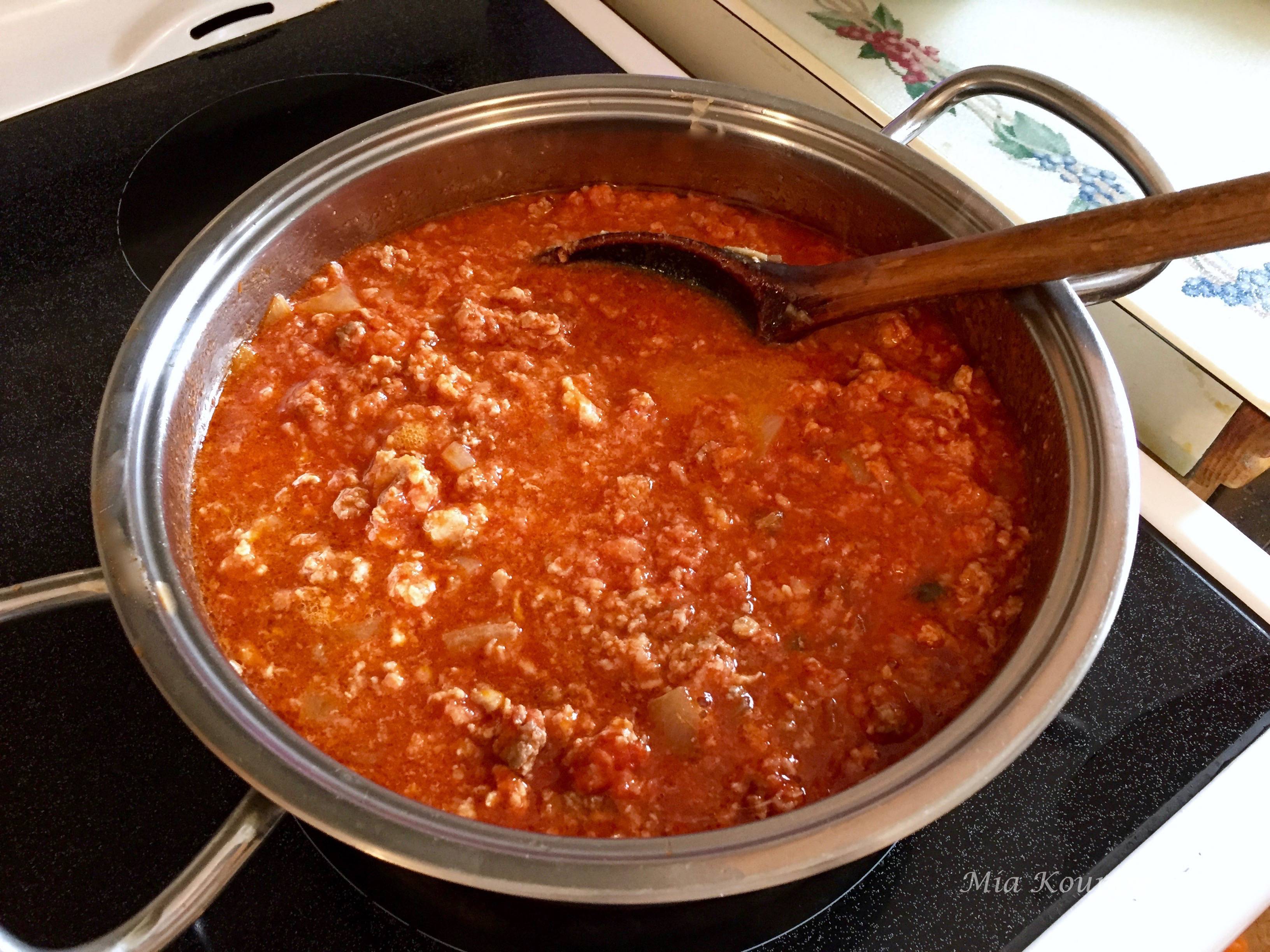
Although the pasta and meat sauce can be prepared ahead, the béchamel sauce really does need to be made the day you are planning to assemble and bake your pastitsio. You will notice in the recipes which follow that our parents’ béchamel sauce contains no butter. This is typical for their cooking, because for them, olive oil is gold and replaces butter in almost all recipes. They also use 2% lactose free milk in their béchamel sauce (although you can use regular milk if you like) and so despite the many eggs, the resultant béchamel is light yet still incredibly flavourful.
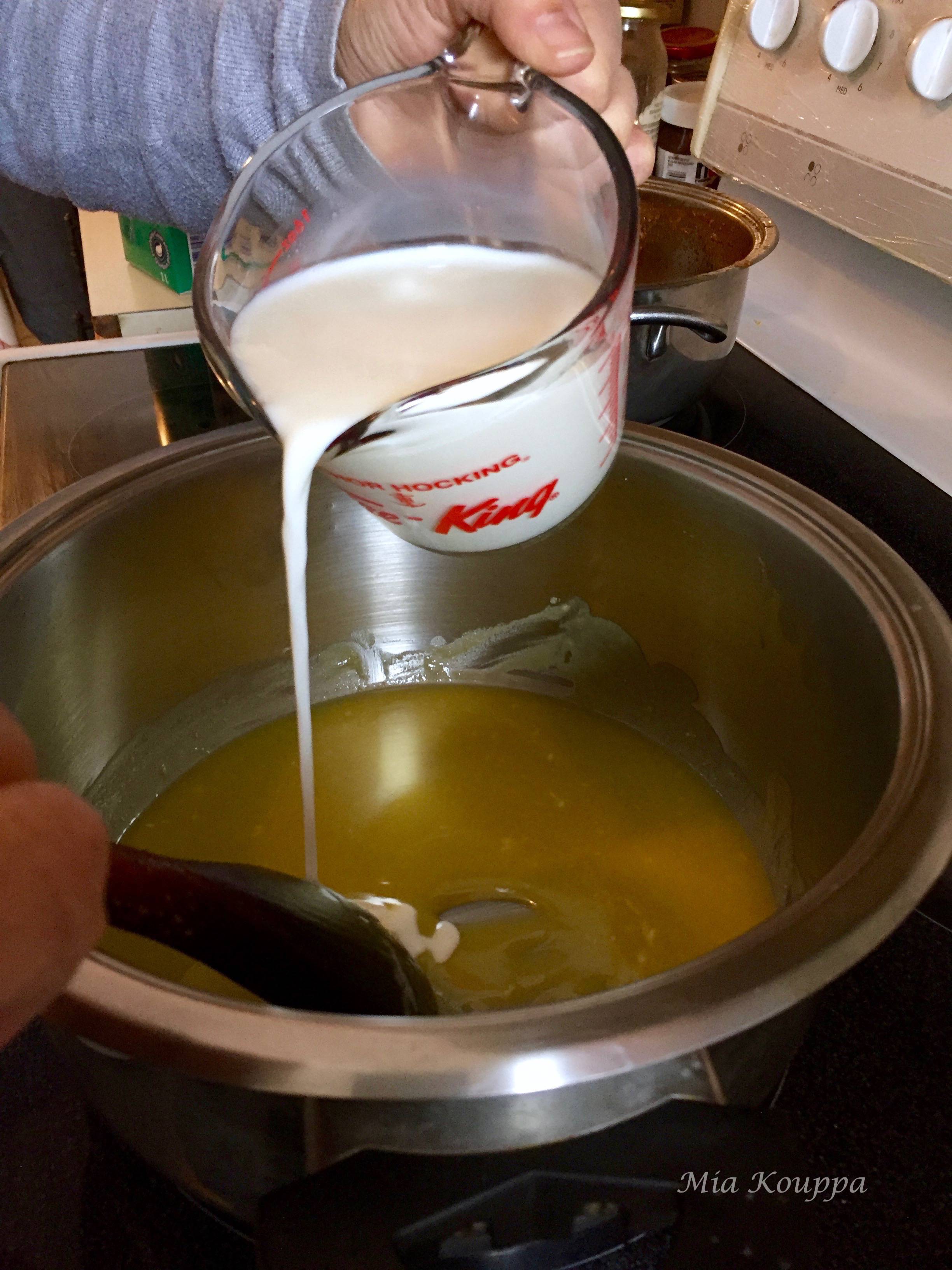
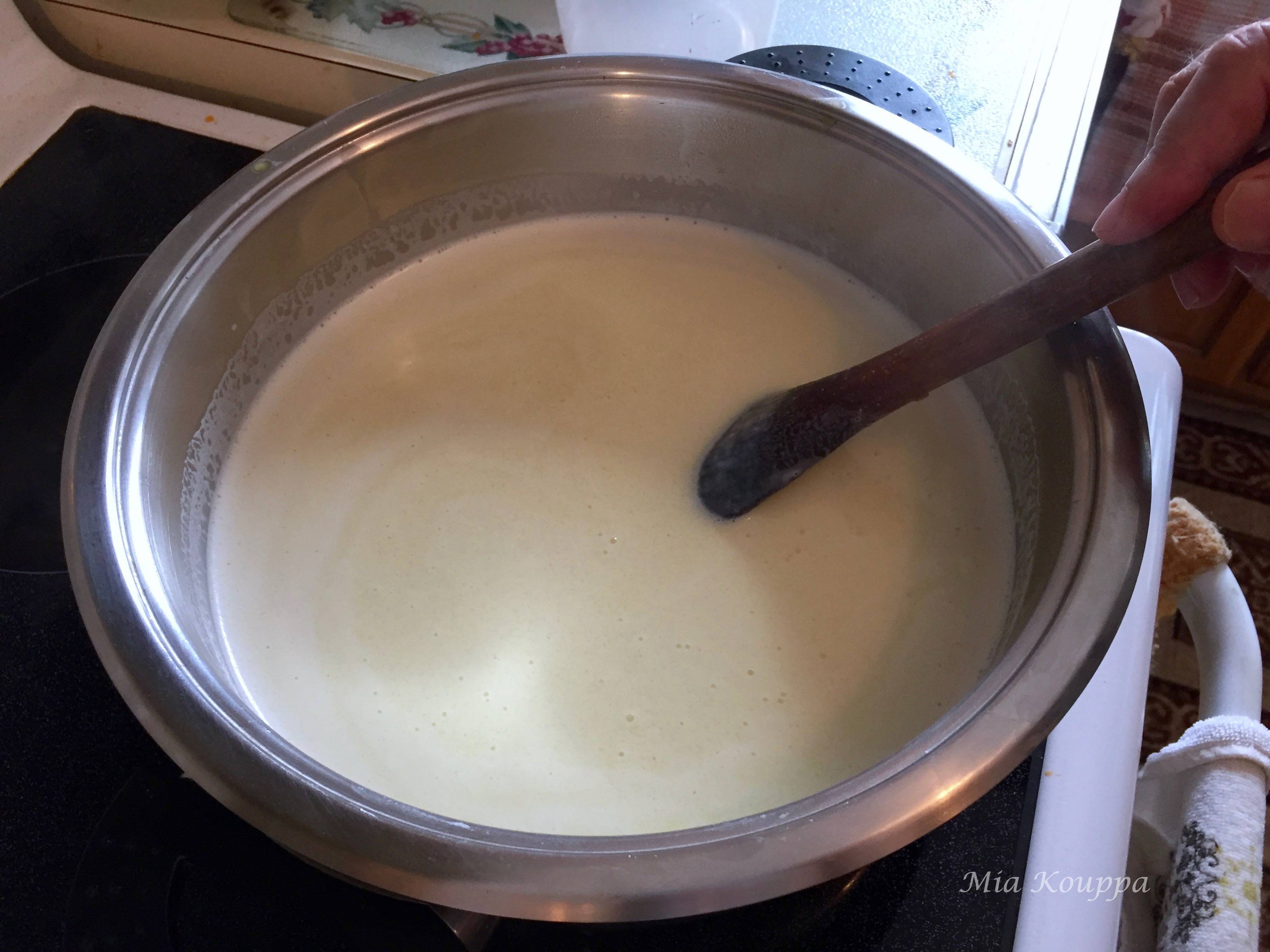
In terms of technique, there are a few things which we feel are important to point out. The first is that although it may appear counter-intuitive, the pasta you will boil should be boiled completely. That is, do not under cook your noodles because you figure they will finish cooking in the oven once the pastitsio is assembled. Second, we noted that our parents have a really neat trick which makes total sense! After pouring the béchamel sauce over the second layer of pasta, our parents use a fork to repeatedly poke into the pan of pastitsio and they wiggle the fork around. What this does is allow the béchamel to seep in between the noodles versus just settling on top. Brilliant!
In terms of the pasta being used, pastitsio is actually quite particular in that you should, if at all possible (and most things are possible) use the tubular spaghetti meant for this dish; what we affectionately call long macaroni. In fact, Greek brands of pasta sell noodles which are called Pastitsio and the ones we use are Pastitsio no. 2 from Misko. If you can’t find these noodles in your local grocery store, the great world of on-line shopping is definitely going to have them.

The first recipe listed below was made for an 11 x 16 inch baking pan, but pastitsio is actually very versatile and very forgiving. If you have a smaller pan, don’t worry. You can easily half the recipe for a pan half the size ( for your convenience, we included a 2nd recipe box below, halving the recipe, to be used for a 9 x 13 inch pan). Otherwise, keep the quantities as they are for the larger pan and you’ll either be faced with enough ingredients to make that large pan of pastitsio, you’ll be able to make two smaller pans, or you’ll have leftovers. Pastitsio component leftovers are super because any extra pasta and meat sauce can simply be served together for an easy meal. As for the béchamel sauce, there are lots of different ways that you can use extras. If you need some inspiration, check this out.
This recipe calls for aged mizithra which is a hard crumbly Greek cheese made with leftover whey from the production of other cheeses, which is then combined with either sheep or goat milk. If you can’t find it, be a little bit sad, and then substitute grated parmesan or romano cheese. Or, try to find it online. Maybe it will be delivered at the same time as your pastitsio pasta!
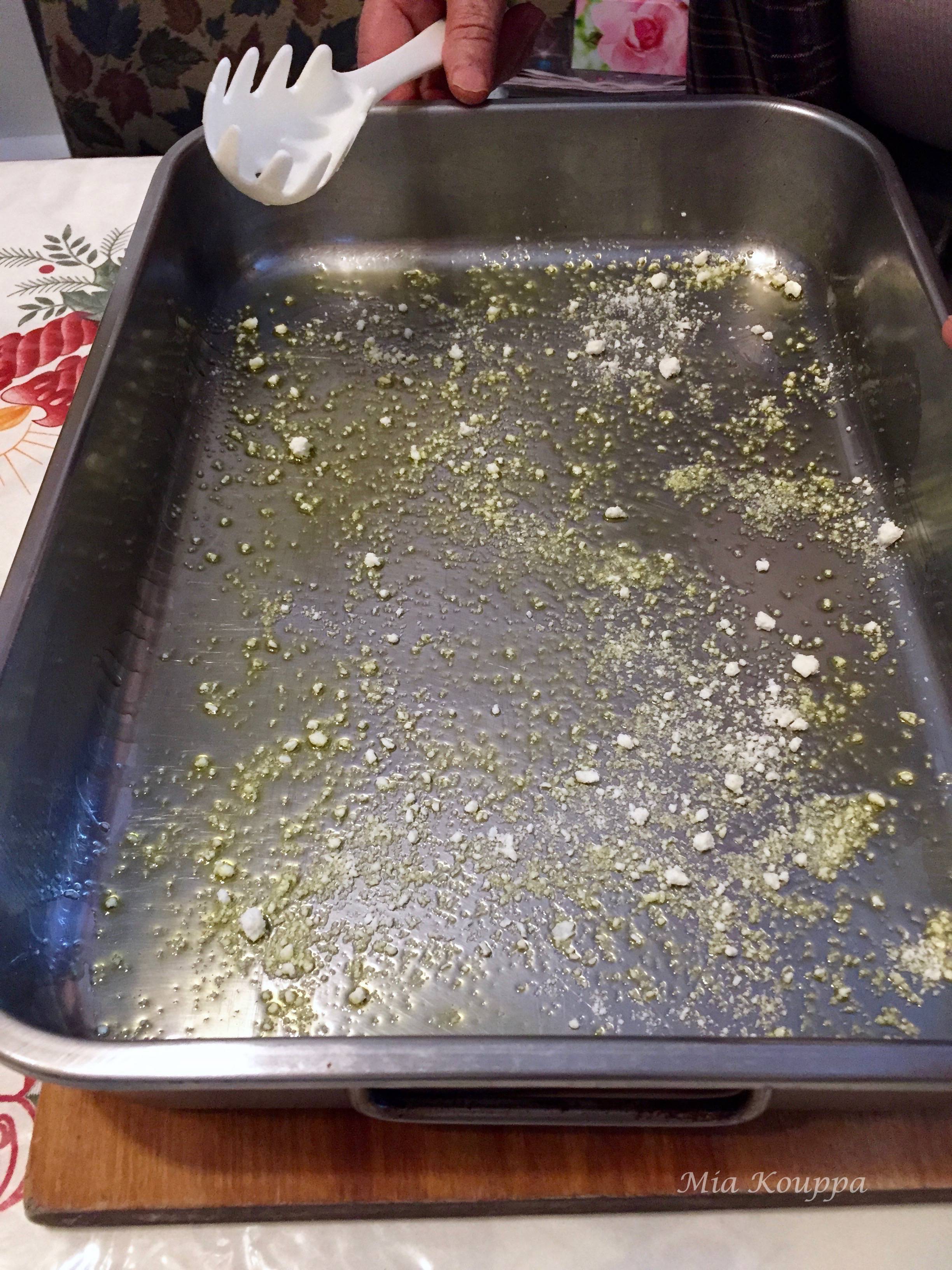
This is our parents very BIG pan!
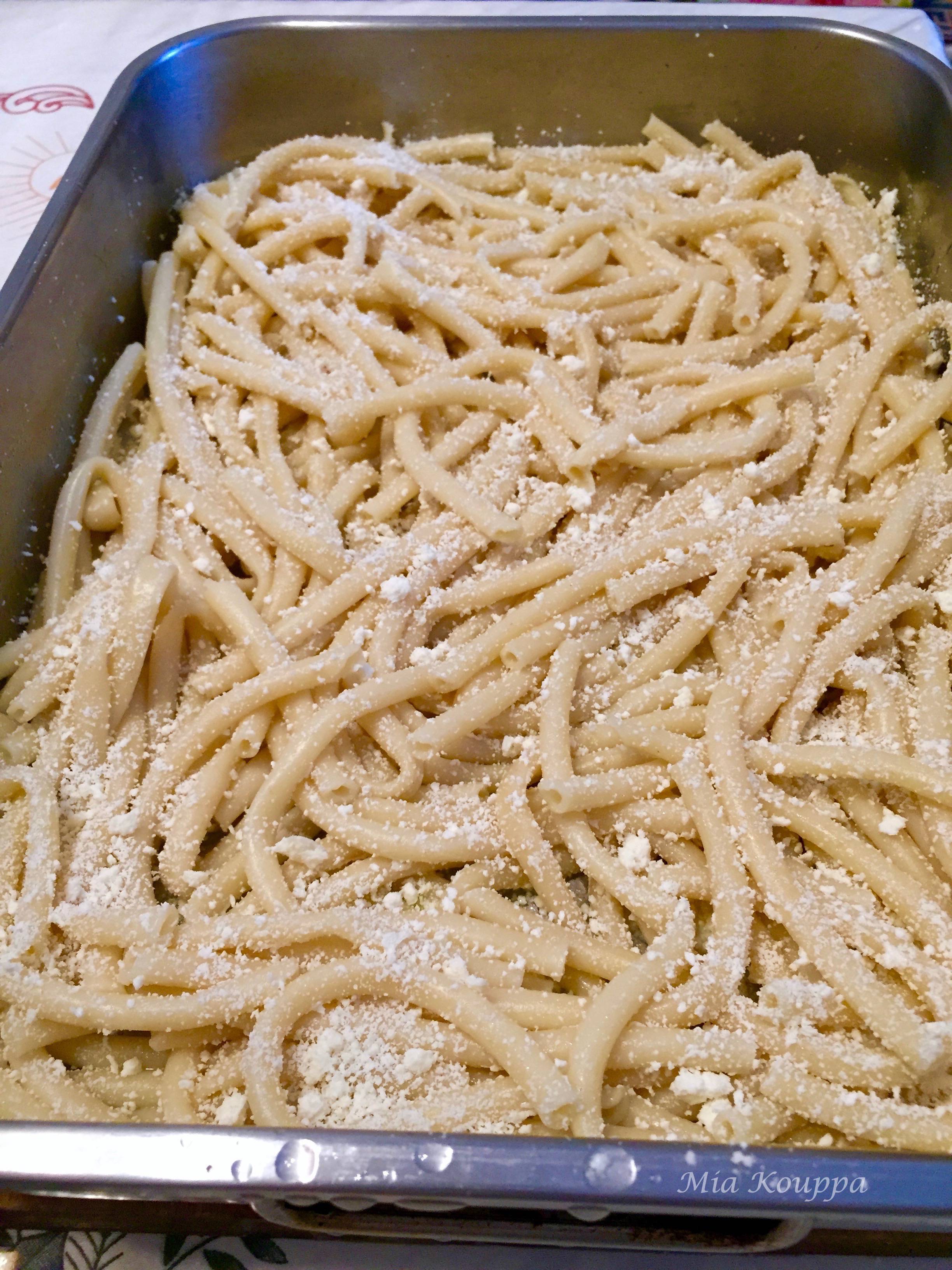
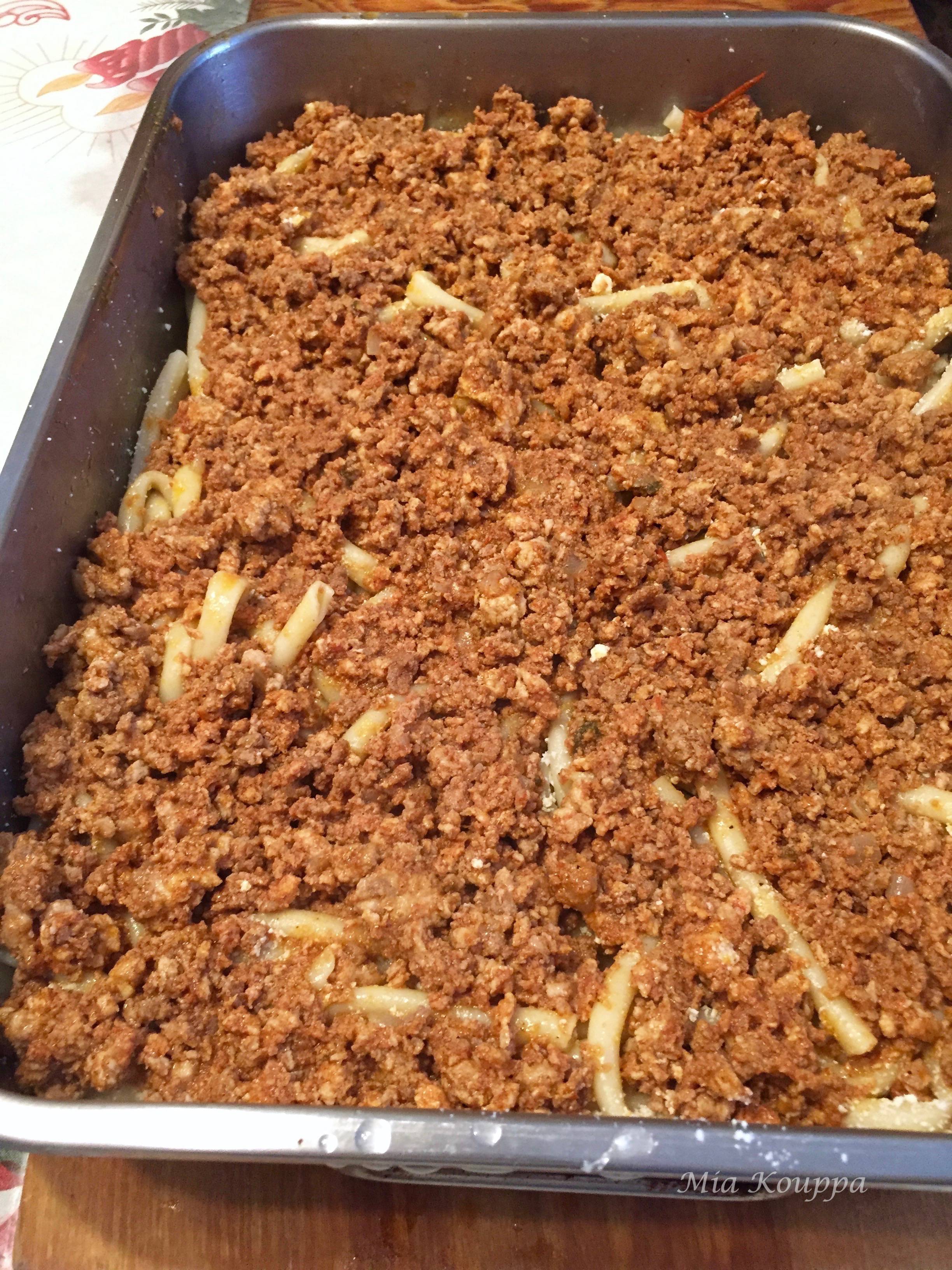
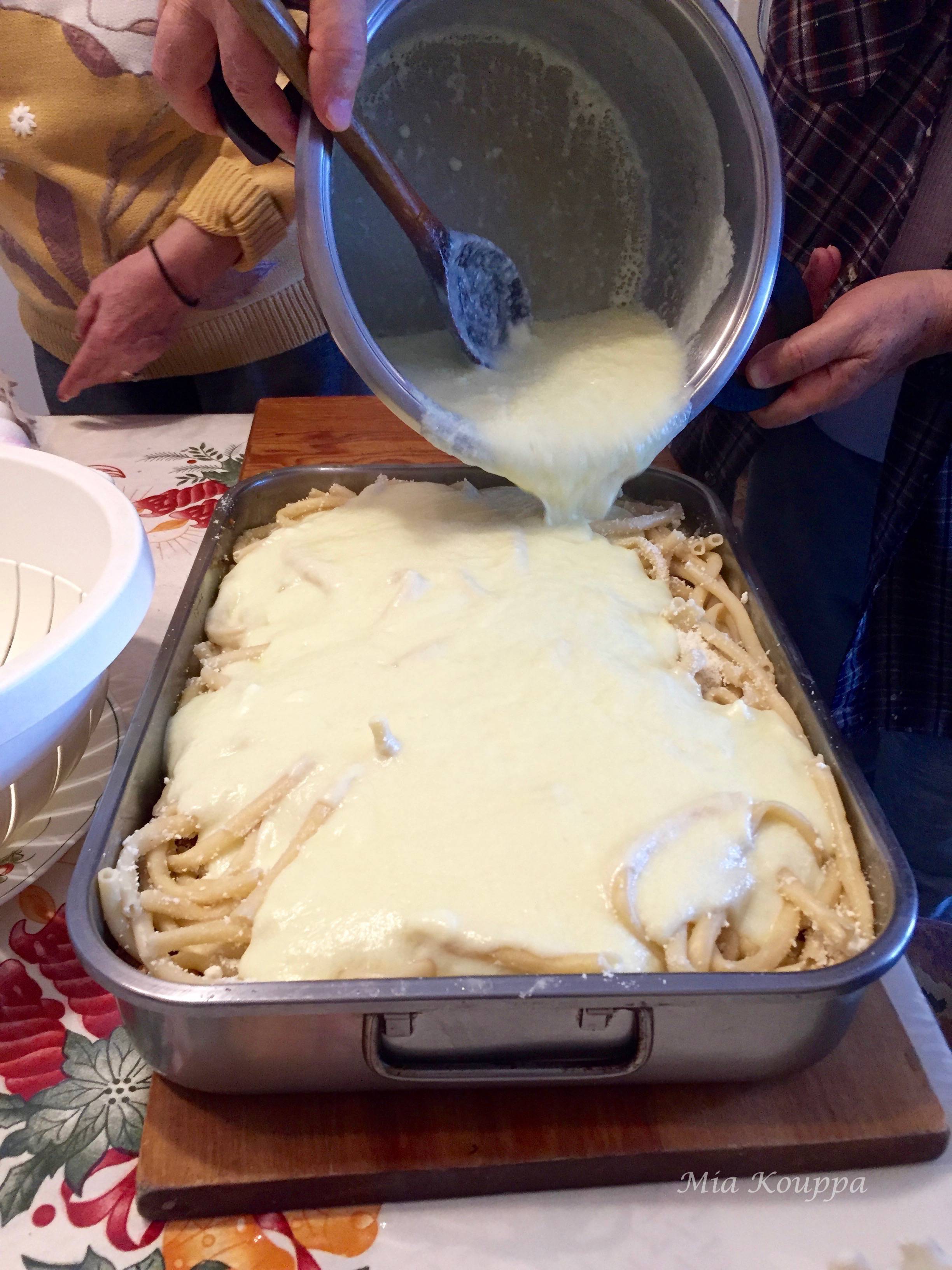
Pin this recipe if you like it!
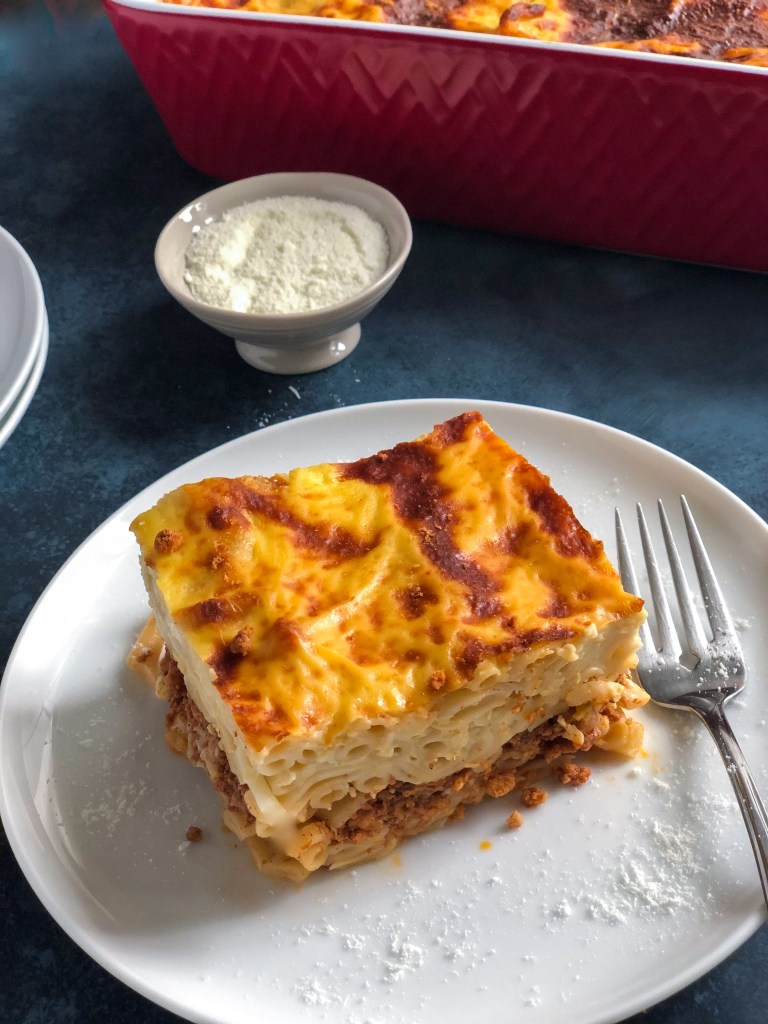

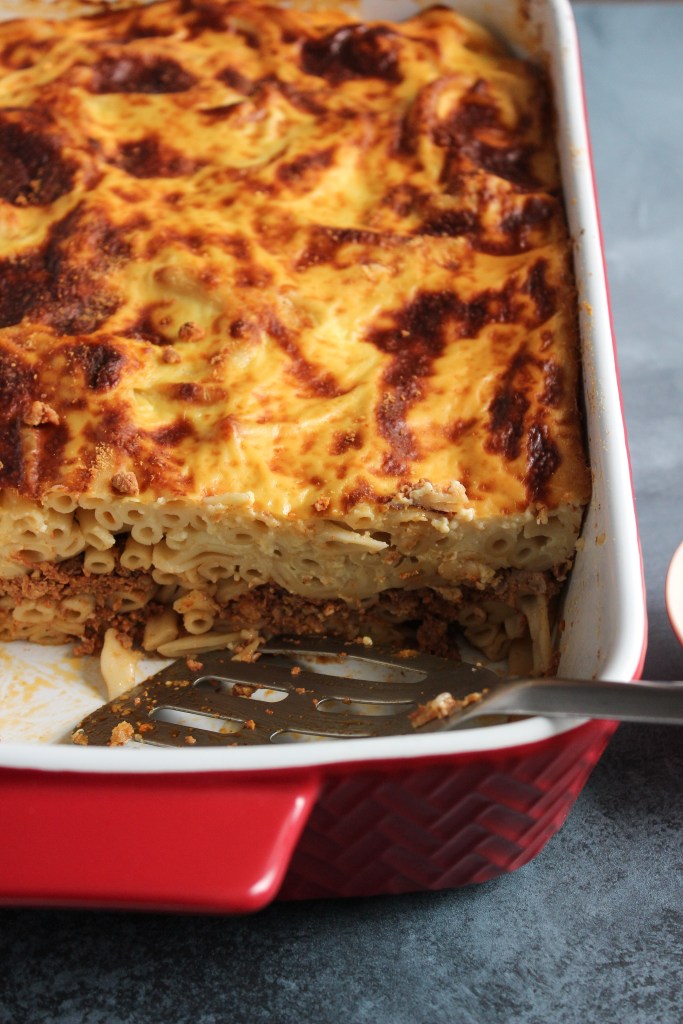
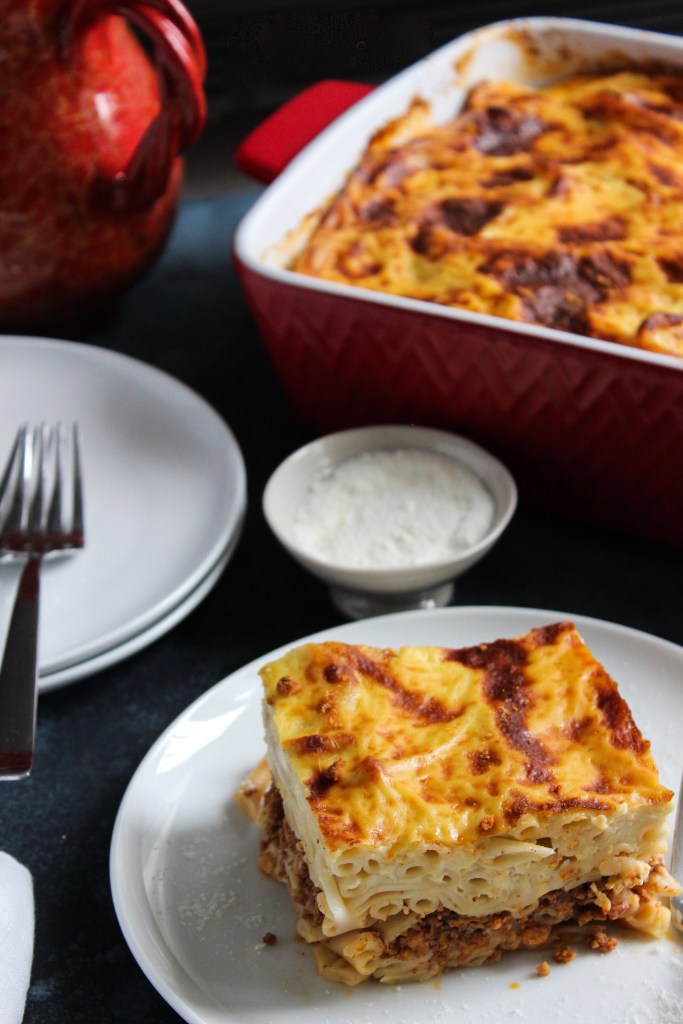

Please note that the 1st recipe below was used for a very large pan: 11 X 16 inches, with a 4 inch depth. If you’re using a more traditional size baking pan: 9 X 13 inches, please see the 2nd recipe box below.
Bravo! Nice to stumble across a Greek food blog. 🙂
Cheers,
Krystina Kalapothakos
Thank you so much! We love your blog too! Opa! to Greek cooking sites 😃😃
Thank you!!!! 🙂
Lets do a collaborate soon too.
Hi there, omg I love your site.
I made the melomakarina recipe last week so delicious had every one asking for the recipe.😀
I am going to attempt to try your Pastichio recipe. I have noticed you don’t add butter in the bechamel sauce. Is this correct? Most bechamel sauces I have googled add butter.
Can you let me know asap as I’m excited to make it.
Have a wonderful day!
Cheers
Kathy
Hi Kathy!! Thanks so much for letting us know that our melomakarona recipe was a hit! We’re so happy to hear that 🙂 As for the pastichio, you are right…there is no butter to be found in the recipe! You may notice that many of our recipes, particularly those that come from our parents, do not have butter. Our parents use olive oil in almost all their recipes, and this includes in their bechamel. We love the way it turns out – light but still creamy and thick. You’ll also notice that our pastichio post actually includes two versions of the recipe; one for a “regular” sized pan, and another for a much larger pan. Scroll through the post to use the one that is best for you. Hope you enjoy the pastichio and we would love to hear back from you!
Thank you for your reply.
Will definitely make it and let you know how it turns out 😀
cant wait to try. will let you know. am already planning
That sounds wonderful! Good luck, and yes, please us know
Hiya, This trick makes a difference •
Then, take a fork and vertically insert it in several areas over the pastitsio and wiggle it around. This will help the béchamel seep in between the top layer of the noodles.
…………………………………………………………………………………………………………………………….
I made the recipe using a meat replacement since I did not have meat: finely ground tofu, almonds and mushrooms : browned and it was delicious. Next time will make with meat. Best bechamel recipe I ever made – easier than I had thought to make. Lovely recipe. Next time will make over 2 days. Thxs for sharing.
Glad to hear it Marina! Great way to use what you have handy… I am sure it was delicious… Stay tuned… within the next couple of months, we will try and post a Vegetarian version of Pastitio… 🙂
[…] will also usually find other roasted meats, Greek cheeses, spanakopites, tyropites, dyed eggs, pastichio, and various side dishes and salads. Remember that many people have followed at least some period […]
[…] and usually do so with great success (like the butter-less béchamel for their moussaka and pastitsio). Often, bruschetta will be made with a thin layer of garlic butter between the crostini and the […]
[…] are not food. Instead she lovingly filled thermoses and containers with things like avgolemono, pastitsio and these […]
it’s too much work to make extra sauce i won’t use. can you please give measurements for amounts needed for just this recipe?
Hi there! Thanks for your interest in Mia Kouppa. Totally understand about the extra sauce; in fact, we were concerned that readers might find it an extra unnecessary expense for this meal, but didn’t really consider the extra work. We’ll take a look at the recipe and see if we can figure out if simply halving it would be sufficient. Thanks 🙂
[…] can be more forgiving. Our parents have made this for a large group of people by baking it in a pastitsio baking pan. Served with some crusty bread and a salad, this is hosting […]
[…] people think about Greek food, they tend to think about the big ones…the pastitsio, moussaka and spanakopita, foods that Greeks and non-Greeks often consider to be the […]
Hello! My mom was Greek & made pastitsio regularly. I learned to make it as a teen & It was a hit always until many years later when our shrimp & roast beef-loving daughter became a vegetarian. Not skipping a beat, I substituted Morningstar Farms Crumbles for ground beef & carried on. It was-and is fantastic! I highly recommend it for all vegetarians yearning for the comfort & flavor of Greek cooking!
Hi Julie! Thanks for your comment. It is great to have options for the vegetarians and vegans in our lives. We also keep to lenten (essentially vegan) meals during periods of fasting. We have posted a vegan pastichio recipe as well. You may enjoy checking it out! https://miakouppabbbwpc.wpcomstaging.com/2017/03/16/vegan-pastichio-%CE%BD%CE%B7%CF%83%CF%84%CE%AF%CF%83%CE%B9%CE%BC%CE%BF-%CF%80%CE%B1%CF%83%CF%84%CE%AF%CF%84%CF%83%CE%B9%CE%BF/
[…] people think about Greek food, they tend to think about the big ones…the pastitsio, moussaka and spanakopita, foods that Greeks and non-Greeks often consider to be the […]
[…] is usually enough food for several days. And amongst the yemista, roasted chicken and potatoes, pastitsio, or any number of other dishes, there is often this pizza. It is almost as if the pizza is an […]
Hi the recipe says I need 900g pastitsio no2 pasta. Is that measures uncooked or cooked? I have the Misko #2 pasta and each package is 500 grams. Thanks!
Hi Helen! Sorry for the delay. We’ve been at the Saveur Blog Conference and were kept a little busy. The weight of the pasta is uncooked, so if would be a pack and a half (approximately) for you.
Hi I love this recipe. You make a dish that is often “ intimidating “ to those that have never made, look easy.
Excellent work!!
I am saving your recipe.
Thank you.
Hi Eleni! Thank you so much for your message, and we’re so happy that you are saving our recipe. We try hard to demystify some of the more “complicated” recipes, so that they are more palatable 🙂 We do hope you give it a try and would love to hear how you enjoy it!
I’m confused about the amount of milk in the bechamel sauce – the ingredients list 2 litres but the instructions say to add 1 litre??
Hi Effy! I think we responded to you on Instagram (or Facebook)…but in case we didn’t this particular post has 2 recipes within it; one for a larger pan, and one for a smaller pan.
I LOVE YOUR SITE!
My parents live in Florida and I don’t get mom’s Greek cooking often enough. I have been craving pastitsio and will be making this recipe to try and WOW my Greek friends 🙂 Can I bake it the day before I want to serve it and reheat it before my dinner guest arrive? Again, thanks for all the great receipes! Yassou!
Thank you so much Catherine!! We are so happy that you have found us, and are enjoying our recipes. You can absolutely make the pastitsio ahead of time, keep it in the refrigerator, and reheat it in the oven on the day that you will serve it. We hope that you and your guests love it as much as we do! xoxo
This recipe looks delicious! I’d like to make it and am wondering how much of the meat sauce is typically used in the dish vs leftover? For example could I get by with about 1 lb/~500 g ground meat and 2.5 cups tomato sauce? Thanks!
Hi Kelly! Our post on pastitsio actually include 2 different recipes; one for a very large pan and one for a more “normal” family sized pan. If you opt for the smaller recipe, you really do need to use all of the meat sauce indicated. With the larger pan you could have about a cup or so of meat sauce left over – or not. Some people like to have their pastitsio with more meat sauce. Hope that helps.
Is there a specific passata recipe you recommend for this? This was my husband’s favorite food my yiayia made so I am making my first attempt at it and want to get it as close to perfect as possible. Thank you!
Hi Evanthia, no, we don’t use a particular brand of passata sauce; you may use whatever you like. However, we do like to use Hunt’s tomato sauce in this recipe, if we don’t have any of our homemade sauce available. Hope this helps, and hope you love it 🙂
Would kefalotiri cheese work in place of mizithra? How do the two cheeses differ?
It would definitely work. Mizithra is a whey cheese made from the milk of sheep, ewe or goat. There are actually 3 types of mizithra which are produced; a fresh and soft form, a sour form, and the one we use here with is the most aged and hard variation of mizithra (it’s often referred to as Anthotyros). It is salty and crumbly, making it great for grating. Kefalotyri is a yellow sharp flavoured cheese which is somewhat salty and made from sheep’s milk. Kefalotyri is also very easy to grate. Hope that is helpful! xox Helen & Billie
We moved to the gulf coast in 2017, alot of our belongings are still in storage. We went and looked for my cookbooks and recipe box that I had all the recipes I’ve made through out the years, one in particular was mom’s pastitsio recipe. yours is very close to hers if I’m not mistaken, I want to make this for Thanksgiving, I will be using 2#s of ground beef & 1# of venison. As far as the cheese goes, I would like to use a combination of Parmesan and Feta, How would that work??
Hi Niki!! Thank you for reaching out, and how wonderful to make pastitsio for Thanksgiving! So thrilled to be invited to your table 🙂 We think that the combination of parmesan and feta would work just fine. You can also use a combination of parmesan and grated romano cheese to substitute for the mizithra (that is what we would recommend as it is more in line with the taste / texture of grated mizithra). Let us know how it works out!! xoxo Helen & Billie
Made a half recipe of this last night. My Greek neighbor gave me a portion for this weekend’s easter celebrations and I remembered how I had liked your version. Again, two great tips: poke holes to allow the bechamel to go down and don’t undercook the pasta.. Thank you.
So happy to hear that Marina!! Thank you for letting us know you love our pastitsio, and appreciate the helpful hints! xoxo Helen & Billie
Hi there. Just making the pastitsio now. Did I need to brown the meat before adding it to the tomato sauce?
Nope! No need to brown the meat. Enjoy!
HI there! Sorry for the delayed response. No, you don’t need to brown the meat before adding it to the tomato sauce! xoxo Helen & Billie
Hello – I love your site and love that you are Canadian. I made your pastitsio recipe a few days ago and it turned out great but I have a few questions / comments. I am a reasonably competent cook and have made lasagna many times. I found that the béchamel was the hardest part. It did not thicken for me until I turned up the heat under the pot, at which point it started to thicken nicely. However, at one point (it probably got too hot) the consistency of the sauce changed to a more granular “eggy” consistency. also, Even though I sprinkled a lot of cheese on top, I found the sauce to be rather bland. I think it would have benefitted from the addition of some cheese as well as salt, pepper and nutmeg. Any comments or suggestions to help me improve the béchamel would be appreciated.
Hi Sabina, Thanks so much for reaching out and apologies in the delay in getting back to you. Thanks for your kind words! The temperature of the bechamel is really important – it sounds like you started off not hot enough, and then too hot. As for the flavour, it is quite a mild bechamel. If you prefer a more pronounced flavour, feel free to add nutmeg, additional cheese, or anything else you would like. Enjoy! xoxo Helen & Billie
Leave a Reply